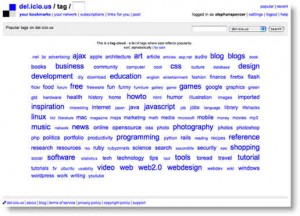Aggregation, syndication and the social engine
del.icio.us is a social bookmarking website.
What does this mean and what are the advantages for workgroups?
Discuss how del.icio.us uses the term ‘tag’ in a different context to what Web publishers would be familiar.
With billions of web-pages, it makes sense that we are able to pull out the best or most useful pages we require, with relative ease. We could bookmark into the browser of our computer but then the links are tied only to one computer - when we switch computers we don’t have access to our bookmarked sites. ![]()
Social bookmarking sites - such as delicious have changed this.
Delicious doesn’t use a browser but uses a website instead. A user signs up for a free account and adds a couple of buttons to the browser - a delicious symbol and a tag symbol.
The delicious symbol - is a link to www.delicious.com which takes the user to the main page of the site showing a list of the newest bookmarks available from users.
The tag symbol - is the button a user presses if they want to add a new bookmark to the website.
When the tag symbol is clicked a new window opens and the user is asked for more information about the site - it is here that key words - tags - are added to describe the site.
Another click - on the save button and the tag is saved to the delicious web site as well as to your own, personl list of tags saved on the delicious site.
A user can repeat this process with any site they wish to tag and save and sites can be sorted by the tags assigned to them. Then, if looking for a particular topic or idea in the future, it can be easily accessed by a user by simply clicking on the appropriate tag in order to retrieve links to relevant sites.
Delicious bookmarks are public - others can see them and use them and in that is ‘Social Bookmarking’ - a user’s bookmarks can benefit other people who have the same interests. Everyone is discovering new and relevant materials for use within their classrooms, for example, and a network is created producing a steady stream of useful and interesting websites all organised by tags on the delicious website.
In a website, tagging works almost like a quick snapshot of the type of information included within the site as well as a means of navigating to information a visitor may want to access within a site. A tag cloud included in a blog, for example, displays all keywords used as tags to posts published within the site. If a particular tag is used in many blog postings it becomes larger in size within the cloud - weighting it or denoting its importance or relevance to the site. The more items or postings a tag has been associated with, the larger the font size. 
The tags within a cloud are also links to the pages within the site containing information centred around them. When clicked all that information is gathered together on one page for easy reading.

herbert
February 11th, 2015 at 03:12
exploiters@mathematically.coyotes” rel=”nofollow”>.…
good info!!…
fred
February 11th, 2015 at 03:52
readers@formidably.stagecoach” rel=”nofollow”>.…
ñïàñèáî çà èíôó!…